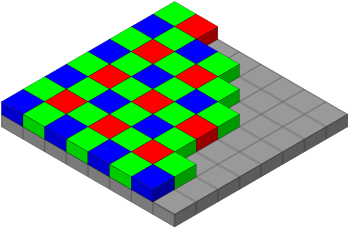Much of this from Foveon X3 sensor and photokonnexion.com
Given the confusion around the 48MP camera on the FP3+ I thought it may be useful for future such issues to read this.
In mobile phone terminology the abbreviation MP can refer both MegaPixels and MegaPhotosites. The word pixel usually refers to an individual spot of a picture > picture-element ( Yes piXel not picel ) and before bayer filters, etc. was also applied to the number of photon sensitive diodes on a sensor array.
The photon sensitive diodes are more properly termed photosites.
The FP3+ has 48MPs not 48MPx. The bayer filter is an overlay of 4 photosites, usually 2 green 1 red and one blue as in the following image, courtesy of wikipedia

Then the sensor computes which colour and depth shall be transferred as a pixel information.
Clearly it would be nice if Fairphone and other’s clarify this by using the term MPs for the camera sensor array and only use MPx for screen array.
Note Samsung have two 108MPs camera sensors , one that uses the ‘tetra cell’ (2 x 2) option to output 27MPx and one that uses a ‘nano cell’ (3 x 3) where the output is 12MP, but there is still the poor interpretation of MP to mean word MegaPixel, when applied to the camera sensor.
Isocell HMX Tetra Cell
While the merging reduces the resolution down to 27Mp from 108Mp, transformed 1.6um pixels increases light sensitivity of the sensor allowing
better results in low light environment.
Isocell HM1 Nano Cell (Samsung Nona)
The HM1 allows users to preview and capture full shots and close-ups of the subject at up to 3x lossless zoom, preserving the quality of the image. This is made possible by the sensor directly converting the pixels using an embedded hardware IP, rather than having the task delegated to the mobile processor. With 108-miillion pixels, the sensor is also able to produce images up to 3x zoom at a 12Mp resolution without upscaling.
XDA ~ Samsung’s approach, therefore, is theoretically the best of both worlds. The phone will dynamically shift between a high-resolution 108MP mode and a 12MP nona pixel binned mode, according to the company. In daylight, it should be able to take ultra-high-resolution 108MP photos to capture far-off details and for more effective cropping, if the image processing is up to scratch. In low light, it will dynamically shift to a 12MP mode, using 9-in-1 pixel binning.